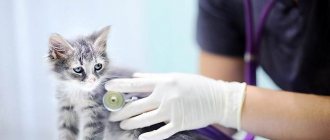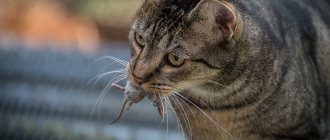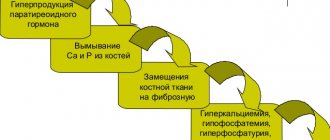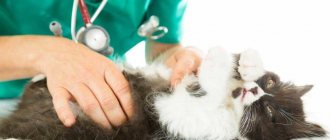Description of the disease
Reference!
Enteritis is a violation of the excretory, secretory and motor functions of the small intestines.
During illness, organ function is disrupted due to inflammation of the internal mucous membranes. If the disease is not immediately detected and treatment is not started, the inflammation will spread to the muscle tissue and serous membrane. In very advanced cases, the prognosis is usually not good and the disease leads to death of the animal.
The causes of the disease may be:
- use of low-quality feed;
- abrupt transition from one food to another;
- drinking bad, contaminated water;
- feeding your pet bones;
- infection with viral or bacterial infections;
- presence of intestinal helminths;
- dysbiosis.
What are the prognosis and prevention?
Forecasts for coronavirus gastroenteritis are not always reassuring. Much depends on the condition of the animal and its ability to fight the virus.
- In half of the cases, the cat is cured, although the unpleasant symptoms are difficult to bear. However, after recovery, the virus will be present in the animal’s feces for another nine months.
- Approximately ten percent of all sick animals die. If treatment is not started on time, the virus takes on a different form and causes serious pathologies of internal organs.
- In rare cases, viral gastroenteritis becomes chronic. The cat periodically experiences symptoms of the disease, but it is possible to cope with them at home. However, the pet will be a carrier of the virus all its life.
In most situations, the prognosis is favorable if treatment is started on time and the owner is attentive to the pet. In rare cases, there are animals whose bodies are resistant to viruses, so they are not susceptible to this disease.
Prevention methods
It is possible to avoid the development of gastroenteritis if you adhere to specific rules. It is necessary to adjust the animal’s nutrition and carefully monitor the quality of food.
- Be sure to periodically give your cat anti-worm medication;
- Avoid contact between your pet and stray animals to avoid infection;
- If there are several cats living in the house, the trays need to be placed in different places;
- If only a lambing individual is infected with coronavirus, then the kittens are taken from her no later than five weeks from birth;
- Animals carrying the virus should not be near healthy cats;
An attentive owner, if you notice a change in your pet’s behavior, contact a veterinarian. Coronavirus is contagious and dangerous; timely treatment will help save the animal’s life. Irritation, a feeling of sand in the eyes, redness are only minor inconveniences with impaired vision. Scientists have proven that decreased vision in 92% of cases ends in blindness.
Crystal Eyes is the best remedy for restoring vision at any age.
Coronavirus gastroenteritis is a dangerous and unpleasant disease that can lead to the death of a cat. The signs appear brightly and intensely, they are impossible not to notice. Treatment is prescribed by a specialist; trying to cure a cat on your own is not recommended.
Types of enteritis in cats
Classification of inflammation in the gastrointestinal tract:
- according to the degree of damage;
- by origin;
- by the predominance of putrefactive or fermentation processes;
- according to the course (acute or chronic).
According to the nature of inflammation, enteritis can be:
- catarrhal;
- fibrinous (characterized by a cheesy coating);
- hemorrhagic (manifested by hemorrhages);
- necrotic (leads to tissue breakdown);
- ulcerative (accompanied by the formation of holes and ulcers in the abdominal cavity).
In addition, enteritis occurs:
- coronavirus;
- parvovirus;
- viral.
In each case, the effectiveness of treatment depends on the pH of the internal environment. If high acidity predominates, the course of the disease will be accompanied by fermentation. With alkaline enteritis, a process of decay occurs, which leads to the formation of toxic substances.
Home care
At home, it is necessary to provide proper care for a sick cat.
It is important to follow a dietary regime. On the first day of treatment, you should not feed the animal.
This is not difficult to do, because the cat will refuse food on its own. On the second and third days, they give liquid oatmeal porridge cooked in meat broth. The fiber contained in cereals helps the stomach recover and improves intestinal functions. On the fourth or fifth day, you need to feed the cat minced meat. If she cannot eat solid food, there is no need to force her. It is enough to give a little meat broth.
If the animal completely refuses to eat, glucose drips are placed to maintain the body.
Water should be available in unlimited quantities. If he does not drink, water is injected behind the cheek with a pipette or syringe without a needle. They do this in small portions, but often. Regidron helps against dehydration.
The place where the sick cat is located should be warm and clean and regularly ventilated.
To recover, a cat needs the attention and affection of its owners.
Photo
What it is
The disease affects the small intestine. The latter, in turn, performs a number of important functions. Let's list them:
- Moving food further into the rectum.
- The production of enzymes that help break down food into simple components. They are divided into indigestible, which will then be released in the form of feces, and absorbable, which will be absorbed by organisms.
- Hormones carry carbohydrates to various parts of the body.
Accordingly, when one of the functions is disrupted, the entire gastrointestinal tract suffers. Waste products gradually accumulate, their transportation is interrupted, and the body is poisoned. The virus is developing rapidly, which leads to the formation of new pathologies. It is worth understanding that the pet suffers more from the consequences than from the coronavirus enteritis itself.
This doesn't mean it shouldn't be treated. The virus provokes diseases such as stomach ulcers, kidney and liver dysfunction, and tissue necrosis throughout the gastrointestinal tract. Of course, if you start the disease, the cat will die. In rare cases, even after a course of treatment, a relapse occurs and the pet dies.
The activity of the virus is very high. Contact with a small amount of feces is enough for it to penetrate into the new carrier. Taking into account the above information, the virus is often activated by “dormant” congeners in the cat’s body.
To be fair, we note that cats that are collected in groups become infected with an infectious disease. This could be a cattery for homeless people or the cohabitation of several cats in an apartment. A normal walk and contact with the feces of an infected individual provokes infection.
Kittens most often become infected from their mother, but importantly, the virus cannot pass through the placenta. Simply put, there is no need to worry about kittens in the cat’s womb.
Infection most often occurs within 40-50 days. During this period, the amount of antibodies that come with milk decreases.
Infection through clothing, touch and other contact is possible, but the chance is extremely small. The fundamental factor is the presence of feces and the virus in it. It poses no danger to humans.
The coronavirus enteritis virus can live in the external environment for up to 7 weeks. In some cases, the cat’s body copes with the disease on its own. This may take up to several months. Symptoms and signs of the disease appear with some frequency. They either fade away or appear in weak forms. Much depends on the immunity of a particular animal.
After contact with contaminated feces, events develop in different ways:
- Up to 10% of cats are affected by infectious peritonitis, which is extremely severe and in most cases leads to the death of the pet.
- A cat becomes infected with coronavirus enteritis, but for several weeks, and sometimes months, the body fights the invader. This is the case when the pet has a strong immune system and the disease can be treated conditionally on its own.
- The cat becomes infected and becomes a carrier of the virus. It is easily detected when taking tests. In some cases, chronic diarrhea occurs.
- The cat is immune to the virus. This area has been little studied, because Finding resistant animals and isolating them is extremely difficult. As a rule, owners contact when the cat is already sick and the first symptoms have appeared. In the case of a preventive examination, such close attention is not paid to searching for the virus. The owner simply doesn't need it.
Coronavirus enteritis in cats
Damage to the upper layer of the internal tissues of the small intestine is coronavirus enteritis.
Symptoms
When infected with coronavirus, an animal practically stops eating, behaves restlessly, sometimes aggressively, and does not react to humans.
In this case it is observed:
- swollen, tight stomach;
- soreness;
- temperature increase;
- vomiting and diarrhea.
Reference!
With coronavirus enteritis, the stool is usually bright red or orange. The consistency is viscous.
How is coronavirus enteritis transmitted?
Most often, the coronavirus is transmitted from an infected individual to a healthy one.
The virus is released into the environment through feces. Infection occurs precisely from direct contact with feces. Animals that are kept in large numbers (for example, in nurseries) and in unsanitary conditions are susceptible to the disease. For animals that do not have access to the street, the chance of becoming infected is minimized, but it still exists and you need to remember this!
Is it dangerous for humans?
The virus poses no danger to humans and is not contagious. Therefore, you don’t have to be afraid of catching enteritis from your pet. Even with direct contact with the animal this is impossible.
How to treat?
The veterinarian, in case of infection with coronavirus enteritis, develops a special treatment regimen, which includes:
- drugs that destroy the type of virus that caused enteritis;
- antibiotics;
- antipyretic (if necessary);
- antispasmodics and painkillers;
- antiemetics and consolidating drugs;
- means restoring water-salt balance;
- immunocorrectors.
How to feed correctly?
Maintaining proper feeding is very important for the treatment to be effective.
A starvation diet is only required if prescribed by a veterinarian. In all other cases, it is necessary to offer your pet easily digestible, warm food in small quantities. In addition, it is necessary to provide access to clean water at room temperature.
Prediction: are there any successful cases?
Usually, after a couple of days of proper care and treatment, the patient’s condition noticeably improves. However, you should stop treatment only after completing the course and final recovery.
Almost all cases of treatment of coronavirus enteritis show positive results. The main thing is to detect the disease as quickly as possible and seek qualified help.
Attention!
A lethal outcome is possible only if the virus mutates and peritonitis develops.
Diagnostics
In order for the veterinarian to make a diagnosis, you must provide him with detailed information on the following points:
- How long does the disease last?
- Is your pet vaccinated and when was he vaccinated?
- What does stool look like, smell and color like?
- When was the animal treated for helminths?
- What have you been fed in the last few days?
Important!
Such information will be useful for any of the three types of enteritis!
Symptoms of enteritis
Loss of appetite and weight are the first signs indicating the development of the disease. These symptoms may not only indicate the development of the disease. After some time, the first symptoms of infection are added to:
- diarrhea (diarrhea) – accompanies a sick animal 5 to 10 times a day;
- molting;
- sunken eyes;
- colic accompanied by gas;
- increased body temperature;
- dry nose;
- lethargy and drowsiness;
- pain in the abdominal wall with light pressure.
Note! When making an accurate diagnosis, it may be necessary to collect feces from the animal. This will help the veterinarian rule out the presence of an infectious process.
The animal refuses food and water. If you have the above symptoms, the only correct solution is to seek help from a veterinarian.
Parvovirus
Panleukopenia, feline distemper and parvovirus enteritis are all names for one terrible disease. There are several types of this disease:
- pulmonary;
- intestinal (enteritis);
- nervous.
Symptoms
Symptoms are usually pronounced and very varied:
- heat;
- depressed state;
- diarrhea and vomiting;
- refusal of food and water;
- nervous tic (twitching);
- swelling of mucous membranes and cough.
Vaccination
A specific means of preventing an animal is its vaccination. Vaccines such as Multifel-3 and Multifel-4 are used for it.
They will protect the fluffy from rhinotracheitis, calcivirus infection, chlamydia, etc.
How to diagnose?
For express diagnosis, the veterinarian needs certain data.
- How and when did the disease begin?
- Frequency of vomiting and bowel movements.
- Consistency, color and volume of stool.
- The behavior of the animal and all changes (is there a refusal of food and water, fear of light, etc.).
Treatment at home
Important!
If the disease is left to take its course and not treated, then in 90% of cases the death of the animal occurs.
Treatment should be comprehensive and only be prescribed by a veterinarian. Most often prescribed:
- medications to relieve symptoms (including prednisolone);
- means that activate the immune system;
- medications to combat the pathogen.
In addition to taking medications, it is necessary to provide the animal with rest, care and concern.
Be sure to remove traces of feces from the animal's fur and bedding. Provide him with a cozy place, without drafts and noise.
How to feed?
For feeding, use only high-quality natural food. This will help the cat overcome diseases faster.
In addition, you can include multivitamins in the diet, which will support the weakened immunity of the animal.
Life prognosis
Treatment of enteritis in cats, started in a timely manner, is effective in most cases. In animals with a non-contagious form of enteritis or gastroenteritis, or in the case of a disease caused by the FECV coronavirus strain, improvement occurs within 2-3 days, but the course of medication must be maintained in full.
However, if an animal is infected with a mutated coronavirus enteritis virus (FIPV strain), then a rapid death cannot be ruled out; the cat’s life expectancy in this case can be only a few months. Veterinary care for such animals is symptomatic in nature, and is mostly aimed at alleviating the general condition.
Viral
Viral or infectious rotavirus enteritis is another form of the disease.
Symptoms
The symptoms are the same as in the previous forms, but diarrhea and vomiting are more pronounced. As a result, rapid dehydration and exhaustion of the body occurs. The following are added to the clinical picture:
- ulcers and wounds in the corners of the mouth;
- dull and pale mucous membranes of the eyes;
- dryness and stiffness of the coat;
- severe abdominal pain.
Reference!
A distinctive feature of feces during rotavirus infection is the presence of blood and mucus.
How to diagnose?
Diagnosis, as in any other case, is made by a specialist in a veterinary clinic based on the clinical picture of the disease and questions about the condition of the pet and its contents; a smear may be prescribed.
Nutrition
Most likely, after a visit to the veterinarian, you will be advised to keep your pet on a starvation diet. On the first day of such a diet, food is not given at all, and part of the water is replaced with medicinal drinks and special solutions that will prevent dehydration of the body. On the second and third days of the diet, the diet includes decoctions of oatmeal in meat broth (do not forget that the cat is a carnivore). After three days, you can offer your pet minced meat.
Attention!
If the animal does not accept solid food, then measure it for porridge and meat broths, which will have a supporting effect for the body weakened by the disease.
Treatment
For treatment, the doctor will prescribe a whole medicinal complex, including:
- Immunoglobulin Globcan-5;
- vitamins;
- antiemetics;
- antibiotics;
- protein mixtures.
Depending on the severity of the disease, other drugs may be added to these medications.
Diagnosis and treatment
The veterinarian takes stool blood tests. Now there are special diagnostic techniques that make it possible to detect in pathological material both the virus and the antibodies produced by the body in response to its introduction. In the event that a litter of kittens is affected and one of them has died, an autopsy is urgently required, followed by sowing of the material. This is not only a diagnosis, but also a chance to develop a suitable therapeutic technique.
If a breeder suspects that one of his pets is a carrier, he can simply take blood from the cat. If there are antibodies specific for FPV, the suspicions are not unfounded. Such animals should be immediately excluded from the reproduction process.
Is there any treatment for parvovirus enteritis in cats? Unfortunately, specific therapy for this disease has not yet been developed. The sooner you see a veterinarian, the better your pet's chance of survival. Many cats recovered with good nutrition, medications for diarrhea and, if necessary, intravenous infusions of buffers. Multivitamin formulations, useful for restoring the general tone of the body of a recovering animal, will not interfere.
How can you prevent the disease? Vaccination is the main method of prevention. The first vaccination is given at the age of eight to nine weeks, and it is repeated after three to four weeks. It is strongly recommended that adult cats be vaccinated annually. You just need to remember that it is not advisable to vaccinate pregnant cats, as there may be negative consequences for the health of unborn kittens.
When a cat feels unwell, many owners look for the cause in poor quality food or a cold. However, signs that accompany non-life-threatening diseases may indicate serious gastrointestinal pathologies. One of the most common diseases among domestic cats is enteritis. It has different varieties, each of which poses a serious threat to the life of the pet.











